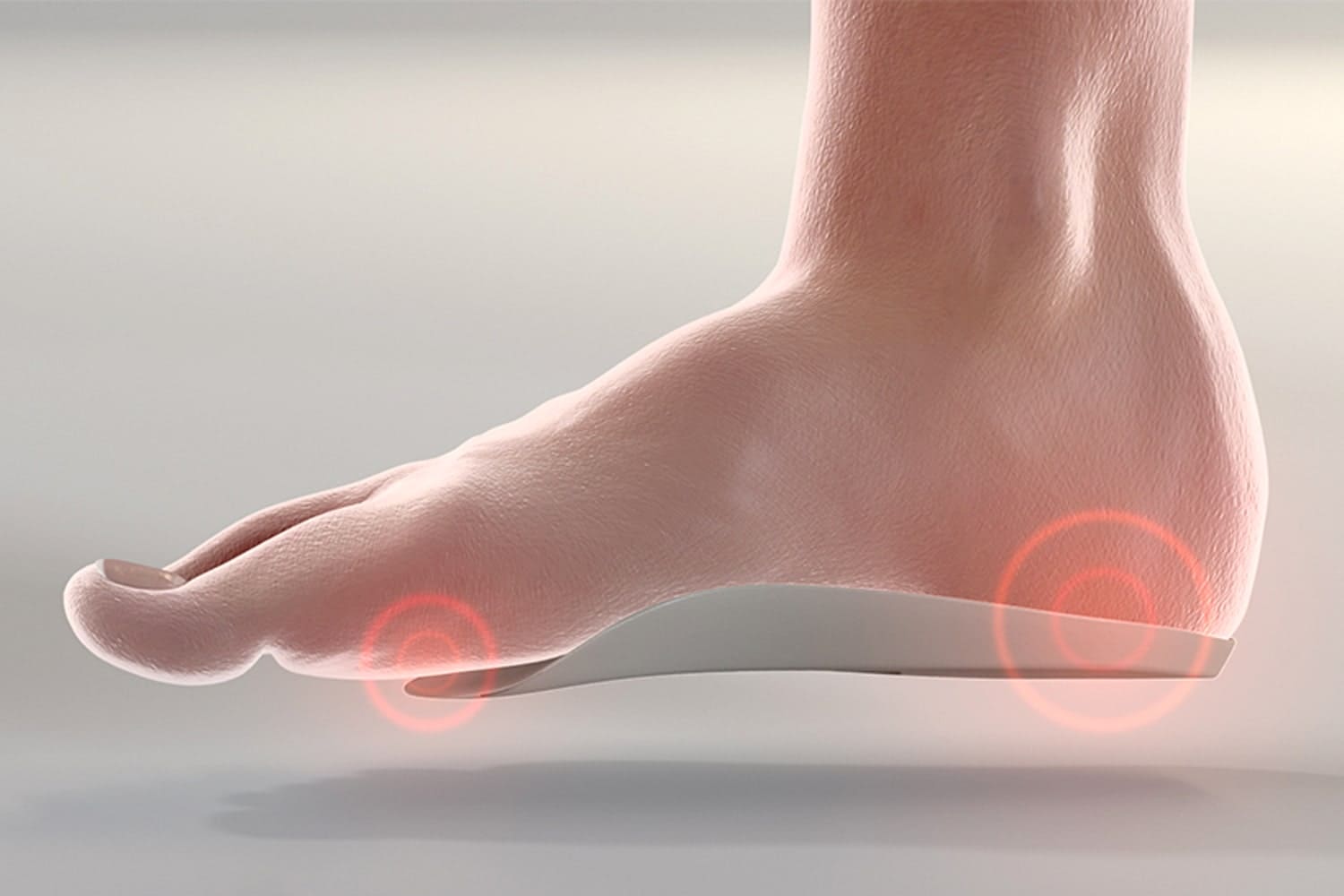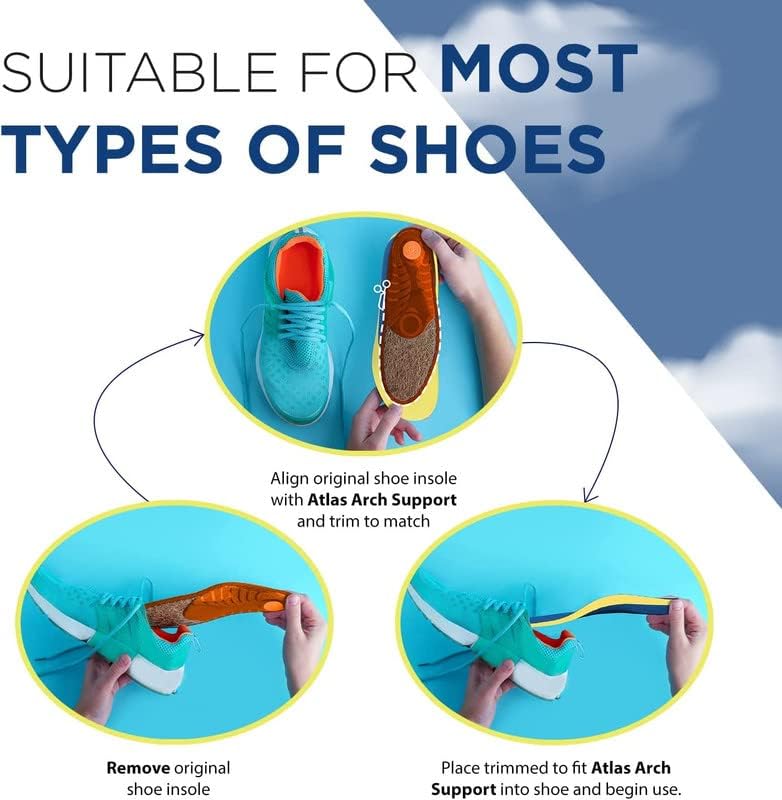Flat feet, also known as fallen arches, is a condition where the arches of the feet collapse, causing the entire sole to come into complete or near-complete contact with the ground.
Flat feet can result from various factors, including genetics, injury, muscle or tendon weakness, or certain medical conditions.
While some people with flat feet may not experience any symptoms or require treatment, others may suffer from discomfort, pain, or other related issues. In such cases, insoles, also known as orthotic inserts or arch supports, can play a significant role in managing the condition and alleviating associated symptoms.
Here we are offering some necessary details for your assistance.
In This Article You’ll Find:
The Impact of Flat Feet:
- Pain or discomfort in the feet, especially around the arches or heels.
- Fatigue or aching in the feet, particularly after prolonged standing or walking.
- Swelling along the inside of the ankle.
- Difficulty in finding properly fitting footwear.
- Foot misalignment may contribute to issues in other parts of the body, such as the knees, hips, or lower back.
How to Approach Healthcare Providers:
Preparing for Your Appointment:
When visiting a healthcare provider for foot pain assessment consider the answers to the following questions:
- When did foot problems first arise?
- What other medical conditions do you have?
- Any family history of flatfeet?
- Have you experienced foot or ankle injuries?
- Have you ever taken any medications and supplements for foot pain?
Expectations from Your Doctor:
During your appointment, expect some inquiries such as:
- Where exactly is the pain located?
- Describe the pain (dull, sharp, burning).
- Factors exacerbating or alleviating pain.
- Impact of footwear on pain.
- Experience with arch supports.
- How pain affects daily life.
Treatment and Therapies:
- For flatfeet not causing pain, the doctor may suggest no treatment is necessary.
- When experiencing painful flatfeet, healthcare providers might recommend:
- Arch Supports (Orthotic Devices):
- Nonprescription or custom-designed arch supports can alleviate pain and reduce symptoms without curing flatfeet.
- Stretching Exercises:
- Exercises targeting a shortened Achilles tendon, often present in individuals with flatfeet, may provide relief.
- Physical Therapy:
- In cases where flatfeet contribute to overuse injuries, a physical therapist can offer exercises to strengthen foot muscles, tendons, and improve gait.
Our Picked 5 Insoles At Your Service:
STSVZORR Orthopedic Insoles
Pros:
- Versatile Compatibility: Compatible with a wide range of shoes.
- Strong Arch Support: Provides durable support for the arch.
- Durable Construction: Made with a long-lasting EVA foam base.
- Multi-layer Cushioning: Offers lasting comfort with multiple layers.
- Enhanced Comfort: Upgraded breathable fabric for increased comfort.

Cons:
- Limited Size Range: Available only in sizes 7-7 1/2.
- Single Color Option: Comes only in Armygreen.
- Material-Specific: Crafted from Ethylene Vinyl Acetate.
Atlas Arch Support Insoles
Pros:
- Comprehensive Relief: Addresses various foot issues like flat feet, plantar fasciitis, and high arches.
- Even Weight Distribution: Distributes weight evenly from heel to toe, enhancing stability.
- Multilayer Construction: Crafted with flexible foam and gel for balance and shock absorption.
- Prevents Arch Collapse: Strong semi-rigid nylon shell maintains a neutral arch position.
- Universal Fit: Fits both wide and narrow feet, suitable for different shoe types.

Cons:
- Initial Discomfort: Users may experience arch pressure initially, requiring adjustment.
- Gradual Usage Recommended: Advised to start with limited usage and gradually increase for comfort.
3ANGNI Arch Support Insoles
Pros:
- Pressure Dispersal: Effectively disperses pressure for various foot conditions.
- Improved Stability: Prevents overpronation, enhancing balance and alignment.
- Metatarsalgia Relief: Provides relief for metatarsalgia and overall foot comfort.
- Adaptable Support: Adapts to most arch shapes for personalized support.
- Dual Cushioning: Features EVA base and PU foam for comfort and impact reduction.

Cons:
- Footwear Limitation: Designed for loose footwear, may not fit all shoe types.
- Individual Fit Variation: One insole may not suit all due to different arch shapes.
HapJump Arch Support Insoles
Pros:
- Podiatrist Recommended: Orthotic support for stabilizing the foot and relieving plantar fasciitis.
- Shock Absorption: Tough construction absorbs shock, reducing fatigue and enhancing productivity.
- Comfortable Design: Hard TPU arch support with cushioning PU memory foam base.
- Breathable Cover: The velvet cover reduces heat and friction, allowing air circulation.
- Customizable Fit: Insole size can be cut for a customized fit.

Cons:
- Adjustment Period: Users may experience foot pressure initially, requiring acclimatization.
- Limited Footwear Compatibility: Fits athletic, walking/running, work, and some casual shoes only.
PowerStep Pinnacle Low Arch Support Insoles
Pros:
- Contoured Arch Support: Firm yet flexible support for low arches or flat feet.
- Overall Comfort: Offers comfort from heel to toe without flattening.
- Alleviates Foot Conditions: Helps with Plantar Fasciitis, Achilles Tendonitis, and more.
- Versatile Use: Easily transferable between shoes without trimming.
- Quality Assurance: Backed by a guarantee of quality and a return policy.

Cons:
- Color Preference: The blue/orange color may not suit everyone’s preference.
- Limited Compatibility: Designed for shoes with removable factory insoles only.
Understanding the Role of Insoles:
Insoles are designed to provide additional support, cushioning, and alignment to the feet. They can help redistribute pressure evenly across the foot, provide stability, and promote proper foot alignment, thereby reducing strain on the muscles and ligaments. For individuals with flat feet, insoles can offer several benefits:
- Arch Support:
- Insoles with arch support can help lift and support the collapsed arches, providing structure and stability to the feet.
- This support helps distribute weight more evenly and reduces excessive pronation (inward rolling) of the foot during movement.
- Shock Absorption:
- Flat feet can increase the impact and strain on the feet, leading to discomfort or pain, especially during high-impact activities.
- Insoles with cushioning properties can absorb shock and reduce the pressure on the feet, providing enhanced comfort and protection.
- Improved Alignment:
- Proper alignment of the feet is crucial for optimal biomechanical function and overall body posture.
- Insoles can help correct foot alignment issues associated with flat feet, promoting better alignment of the feet, ankles, knees, and hips.
- Reduced Fatigue:
- By providing support and cushioning, insoles can help reduce fatigue and discomfort associated with flat feet, allowing individuals to engage in daily activities with greater ease and comfort.
- Prevention of Overuse Injuries:
- Flat feet can increase the risk of overuse injuries, such as plantar fasciitis, shin splints, or Achilles tendonitis.
- Insoles can help alleviate excessive strain on the feet and lower limbs, reducing the likelihood of developing such injuries.
You can also explore other ideas:
5 Ways ArchRelief Revolutionizes Foot Comfort: Discover Customized Support Today!
Addressing Foot Problems: Insoles as Effective Solutions
Aching Arches? Try These Supportive Tips!
Choosing the Right Insoles:
When selecting insoles for flat feet, it’s essential to consider individual factors such as foot shape, arch height, level of pronation, and specific symptoms. Some key considerations include:
- Arch Support: Look for insoles with adequate arch support to help lift and support the arches of the feet.
- Cushioning: Choose insoles with sufficient cushioning to provide shock absorption and comfort, especially for individuals with sensitive or fatigued feet.
- Material: Consider insoles made from durable and breathable materials that provide both support and comfort without causing irritation or discomfort.
- Customization: For individuals with unique foot anatomy or specific requirements, custom-made orthotic insoles may offer a more tailored and effective solution.
Get your Insoles:
best arch supports orthotics inserts
best arch support insoles for standing all day
best insoles for plantar fasciitis
best athletic insoles for women and men
best high arch support insoles
best arch support insoles for runners
Incorporating Insoles into Daily Routine:
To maximize the benefits of insoles for flat feet, it’s essential to wear them consistently and incorporate them into daily activities. Here are some tips for effectively using insoles:
- Wear Them in Appropriate Footwear: Use insoles in shoes that provide adequate support and accommodate the additional volume of the insoles without causing discomfort or constriction.
- Gradual Adjustment: Allow your feet to gradually adjust to wearing insoles, especially if you’re not accustomed to them.
- Start by wearing them for short periods and gradually increase the duration as your feet adapt.
- Regular Replacement: Replace insoles periodically, as they can wear out over time and lose their effectiveness.
- Inspect them regularly for signs of wear and tear, and replace them as needed to maintain optimal support and cushioning.
Lifestyle and Home Remedies For Flat Feet:
For minor pain relief from flat feet, consider:
- Rest: Avoid activities exacerbating the condition, opting for low-impact exercises like walking, biking, or swimming.
- Arch Supports: Non-prescription supports can enhance comfort.
- Medications: Over-the-counter pain relievers like ibuprofen or naproxen sodium might help.
- Weight Loss: Reducing weight can alleviate stress on the feet.
Conclusion:
Flat feet can pose challenges and discomfort for many individuals, but with the right support and management strategies, it’s possible to alleviate symptoms and improve foot function. Insoles play a crucial role in providing support, stability, and comfort for individuals with flat feet, helping them maintain an active and pain-free lifestyle. By understanding the role of insoles and selecting the appropriate type for your needs, you can effectively manage flat feet and enjoy greater comfort and mobility in your daily activities.










Thanks for sharing. I read many of your blog posts, cool, your blog is very good.
Your article helped me a lot, is there any more related content? Thanks!